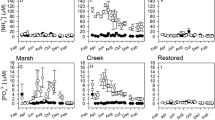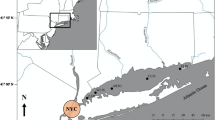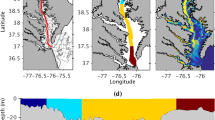Abstract
Multiple stressors affect estuarine shorelines including erosion, sea level rise and impacts from human development of adjacent lands. Increasingly common features of coastal development are vertical shoreline stabilization structures such as bulkheads. Bulkheads are designed to prevent land loss and flooding through the construction of a vertical wall anchored to the land. However, they break the connection between land and water and are barriers to upland plant migration. This disconnect can affect hydrology, alter nutrient and sediment supplies, and lead to marsh loss. We measured the effects of bulkheads on sediment nitrogen fluxes, including denitrification (DEN), at three representative estuarine shoreline types: natural marsh (no bulkhead), bulkhead without marsh, and bulkheads with marshes of varying widths. Sediment cores were taken mid-marsh or, 2 m seaward of bulkhead in sites lacking marsh in northern, central and southern coastal regions of North Carolina. Concentrations of N2 and O2 were measured using a membrane inlet mass spectrometer. In addition, sediment organic matter and inorganic nitrogen concentrations were quantified. Average DEN rate was 93.1 ± 7.0 µmol N m−2 h−1 with the highest rates in the summer and lowest rates in the winter. Sediment oxygen demand was positively correlated with DEN rate (R2 = 0.43, p < 0.01), which suggests that DEN is affected by carbon lability. DEN was not affected by bulkhead presence (R2 = 0.01, p = 0.52), but marsh presence significantly affected yearly DEN rates (R2 = 0.13, p < 0.01). These data indicate that bulkheads do not directly affect nitrogen processing, but indirectly reduce cycling rates through marsh loss.





Similar content being viewed by others
References
Addy K, Gold A, Nowicki B, McKenna J, Stolt M, Groffman P (2005) Denitrification capacity in a subterranean estuary below a Rhode Island fringing salt marsh. Estuaries 28(6):896–908
Ball DF (1964) Loss-on-ignition as an estimate of organic matter and organic carbon in non-calcareous soils. Soil Sci 15(1):84–92
Beauchamp EG, Trevors JT, Paul JW (1989) Carbon sources for bacterial denitrification. Springer-Verlag New York Inc., New York
Bozek CM, Burdick DM (2005) Impacts of seawalls on saltmarsh plant communities in the Great Bay Estuary, New Hampshire USA. Wetl Ecol Manag 13:553–568
Bricker SB, FerreiraJG Simas T (2003) An integrated methodology for assessment of estuarine trophic status. Ecol Model 169(1):39–60
Broome SW, Craft CB (2000) Tidal salt marsh restoration, creation, and mitigation. In: Barnhisel RI, DarmodyRG Daniels WL (eds) Reclamation of drastically disturbed lands, American society of agronomy. Crop Science Society of America, Soil Science Society of America, Madison
Brush G (2009) Historical land use, nitrogen, and coastal eutrophication: a paleoecological perspective. Estuar Coasts 32:18–28
Cloern JE (2001) Our evolving conceptual model of the coastal eutrophication problem. Mar Ecol Prog Ser 210:223–253
Corbett DR, Walsh JP, Cowart L, Riggs SR, Ames DV, Culver SJ (2008) Shoreline change within the Albemarle-Pamlico estuarine system, North Carolina. East Carolina University. http://www.ecu.edu/icsp/ICSP/Reports.html. Accessed 18 Feb 2010
Cornwell JC, Kemp WM, Kana TM (1999) Denitrification in coastal ecosystems: environmental controls and aspects of spatial and temporal scale. Aquat Ecol 33:41–54
Crosset KM, Culliton TJ, Wiley PC, Goodspeed TR (2004) Popoulations trends along the coastal United States: 1980–2008. National Oceanic and Atmospheric Administration, National Ocean Service. http://oceanservice.noaa.gov/programs/mb/pdfs/coastal_pop_trends_complete.pdf. Accessed 4 June 2014
Currin CA, Chappell WS, Deaton A (2010) Developing alternative shoreline armoring strategies: the living shoreline approach in North Carolina. In: Shipman H, Dethier M, Gelfanbaum G, Fresh KL, Dinicola RS (eds) Puget sound shorelines and the impacts of armoring-proceedings: USGS Scientific Investigations Report, pp 91–102
Davidsson TE, Stahl M (2000) The influence of organic carbon on nitrogen transformations in five wetland soils. Soil Sci Soc Am J 64:1129–1136
Dodla SK, Wang JJ, DeLaune RD, Breitenbeck GA (2008) Denitrification potential and its relation to organic carbon quality in the three coastal wetland soils. Sci Total Environ 407:471–480
Doody JP (2013) Coastal squeeze and management realignment in southeast England, does it tell us anything about the future? Ocean Coast Manag 79:34–41
Eyre BD, Rysgaard S, Dalsgaard T, Christensen RB (2002) Comparison of isotope pairing and N2: Ar methods for measuring sediment denitrification-assumptions, modifications and implications. Estuaries 25:1077–1087
Fear JM, Currin CA (2012) Sustainable estuarine stabilization: research, education and public policy in North Carolina. Final Report. The NOAA/UNH Cooperative Institute for Coastal and Estuarine Environmental Technology (CICEET). Grant Number NA06NOS4190167
Fear JM, Thompson SP, Gallo TE, Paerl HW (2005) Denitrification rates measured along a salinity gradient in the eutrophic Neuse River Estuary, North Carolina, USA. Estuaries 28(4):608–619
Ferguson AJP, EyreBD GayJM (2003) Organic matter and benthic metabolism in euphotic sediments along shallow sub-tropical estuaries, northern New South Wales, Australia. Aquat Microb Ecol 33:137–154
Field DW, Reyer AJ, Genovese PV, Shearer BD (1991) Coastal wetlands of the United States: An accounting of a valuable national resource. National Oceanic and Atmospheric Administration
Francis CW, Mankin JB (1977) High nitrate denitrification in continuous flow-stirred reactors. Water Res 11:289–294
Gardner WS, McCarthy MJ (2009) Nitrogen dynamics at the sediment water interface in shallow, subtropical Florida Bay: why denitrification efficiency may decrease with increased eutrophication. Biogeochemistry 95:185–198
Giblin AE, Weston NB, Banta GT, Tucker J, Hopkinson CS (2010) The effects of salinity on nitrogen losses from an oligohaline estuarine sediment. Estuar Coasts 33:1054–1068
Glass C, Silverstein J, Oh J (1997) Inhibition of denitrification in activated sludge by nitrite. Water Environ Res 69(6):1086–1093
Groffman PM, Altabet MA, Bohlke JK, Butterbach-Bahl K, David MB, Firestone MK, Giblin AE, Kana TM, Nielsen LP, Voytek MA (2006) Methods for measuring denitrification: diverse approaches to a difficult problem. Ecol Appl 16:2091–2122
Herbert RA (1999) Nitrogen cycling in coastal marine ecosystems. FEMS Microbiol Rev 23:563–590
Hernanadez ME, Mitsch WJ (2007) Denitrification potential and organic matter as affected by vegetation community, wetland age, and plant introduction in created wetlands. J Environ Qual 36:333–342
Kana TM, Darkangelo C, Hunt MD, Oldham JB, Bennett GE, Cornwell JC (1994) Membrane inlet mass spectrometer for rapid high-precision determination of N2, O2, and Ar in environmental water samples. Anal Chem 66:4166–4170
Kaplan W, Valiela I, Teal JM (1979) Denitrification in a salt marsh ecosystem. Limnol Oceanogr 24(4):726–734
Kim IS, Oh SE, Bum MS, Lee JL, Lee ST (2002) Monitoring the denitrification of wastewater containing high concentrations of nitrate with methanol in a sulfur-packed reactor. Appl Microbiol Biot 59:91–96
Koop-Jakobsen K, Giblin AE (2010) The effect of increased nitrate loading on nitrate reduction via denitrification and DNRA in salt marsh sediments. Limnol Oceanogr 55(2):789–802
Lance JC, Rice RC, Whisler FD (1978) Effects of vegetation on denitrification and phosphate movement during rapid infiltration of soil columns. Water Pollut Control 50(9):2183–2188
Long SP, Mason CF (1983) Saltmarsh ecology. Blackie, New York
Magalhaes CM, Joye SB, Moreira RM, Wiebe WJ, Bordalo AA (2005) Effect of salinity and inorganic nitrogen concentrations on nitrification and denitrification rates in intertidal sediments and rocky biofilms of the Douro River estuary, Portugal. Water Res 39:1783–1794
McMillan SK, Pihler MF, Thompson SP, Paerl HW (2010) Denitrification of nitrogen released from senescing algal biomass in coastal agricultural headwater streams. J Environ Qual 39(1):274–281
Millennium Ecosystem Assessment (2005) Ecosystems and human well-being: wetlands and water synthesis. World Resources Institute, Washington
Miller-Way T, Twilley RR (1996) A comparison of batch and continuous flow methodologies for determining benthic fluxes. Mar Ecol Prog Ser 140:257–269
Narkis N, Rebhun M, Sheindorf CH (1979) Denitrification at various carbon to nitrogen ratios. Water Res 13:93–98
National Research Council (NRC) (2000) Clean coastal waters: understanding and reducing the effects of nutrient pollution. National Academy Press, Washington
National Research Council (NRC) (2007) Mitigating shoreline erosion along sheltered coasts. National Academy Press, Washington
Owens MS (2009) Nitrogen cycling and controls on denitrification in mesohaline sediments of Chesapeake Bay. Thesis, University of Maryland
Paerl HW, Pinckney JL, Fear JM, Peierls BL (1998) Ecosystem responses to internal watershed organic matter loading: consequences for hypoxia in the eutrophying Neuse River Estuary, North Carolina. Mar Ecol Prog Ser 166:17–25
Paerl HW, Dennis RL, Whitall DR (2002) Atmospheric deposition of nitrogen: implications for nutrient over-enrichment of coastal waters. Estuaries 25(4b):677–693
Paerl HW, Valdes LM, Joyner AR, Piehler MF, Lebo ME (2004) Solving problems resulting from solutions: evolution of a dual nutrient management strategy for the eutrophying Neuse River Estuary, North Carolina. Environ Sci Technol 38:3068–3073
Piehler, MF, Smyth AR (2011) Habitat-specific distinctions in estuarine denitrification affect both ecosystem function and services. Ecosphere 2(1):Article 12
Price CB, Cerco C, Gunnison D (1994) Sediment oxygen demand and its effects on dissolved oxygen concentrations and nutrient release; initial laboratory studies. Technical Report W-94-1. United States Army Corps of Engineers
Rysgaard S, Thastum P, Dalsgaard T, Christensen PB, Sloth NP (1999) Effects of salinity on NH4 + adsorption capacity, nitrification, and denitrification in Danish estuarine sediments. Estuaries 22(1):21–30
Santos IR, Burnett WC, Canton J, Mwashote B, Suyaputra IGNA, Dittmar T (2008) Nutrient biogeochemistry in a Gulf of Mexico subterranean estuary and groundwater derived fluxes to the coastal ocean. Limnol Oceanogr 53(2):705–718
Schlesinger WH (1991) Biogeochemistry: an analysis of global change. Academic Press Inc., San Diego
Scott JT, McCarthy MJ, Gardner WS, Doyle RD (2008) Denitrification, dissimilatory nitrate reduction to ammonium, and nitrogen fixation along a nitrate concentration gradient in a freshwater wetland. Biogeochemistry 87:99–111
Seitz RD, Lipcius RN, Olmstead NH, Seebo MS, Lambert DM (2006) Influence of shallow-water habitats and shoreline development on abundance, biomass, and diversity of benthic prey and predators in Chesapeake Bay. Mar Ecol Prog Ser 326:11–27
Smith CJ, Delaune RD, Patrick WH Jr (1983) Nitrous oxide emission from Gulf Coast Wetlands. Geochim Cosmochim Acta 47:1805–1814
Smyth AR, Thompson SP, Siporin KN, Gardner WS, McCarthy MJ, Piehler MF (2013) Assessing nitrogen dynamics throughout the estuarine landscape. Estuar Coasts 36:44–55
Spiteri C, Slomp CP, Tuncay K, Meile C (2008) Modeling biogeochemical processes in subterranean estuaries: effects of flow dynamics and redox conditions on submarine groundwater discharge of nutrients. Water Resour Res 44:W02430. doi:10.1029/2007WR006071
Talbot JM, Kroeger KD, Rago A, Allen MC, Charette MA (2003) Nitrogen flux and speciation through the subterranean estuary of Waquoit Bay, Massachussets. Biol Bull 2005:244–245
Titus JG (1986) Greenhouse effect, sea level rise, and coastal zone management. Coast Zone Manage J 14(3):147–171
United States Army Corps of Engineeris (1995) Design of coastal revetments, seawalls, and bulkheads. Engineer Manual 1110-2-1614. United States Department of Army, Washington
Vitousek PM, Mooney HA, Lubchenco J, Melillo JM (1997) Human domination of Earth’s ecosystems. Science 277:494–499
Acknowledgments
The authors would like to thank Corey Adams, Rebecca Schwartz, Kaylyn Siporin, and Ashley Smyth for their assistance in both the field and laboratory, as well as, Dr. John Fear for editing this manuscript.
Funding
Funding for this project was provided by the Cooperative Institute for Coastal and Estuarine Environmental Technology (CICEET).
Author information
Authors and Affiliations
Corresponding author
Rights and permissions
About this article
Cite this article
O’Meara, T., Thompson, S.P. & Piehler, M.F. Effects of shoreline hardening on nitrogen processing in estuarine marshes of the U.S. mid-Atlantic coast. Wetlands Ecol Manage 23, 385–394 (2015). https://doi.org/10.1007/s11273-014-9388-9
Received:
Accepted:
Published:
Issue Date:
DOI: https://doi.org/10.1007/s11273-014-9388-9




